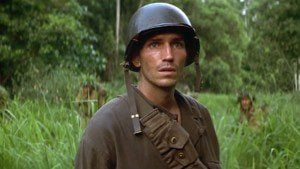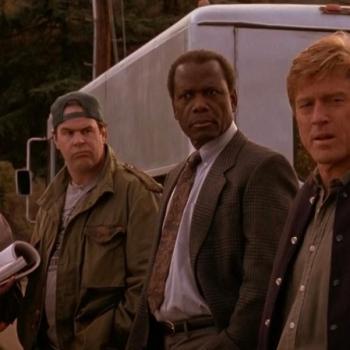 Terrence Malick’s The Thin Red Line is a brooding and introspective look at war, and with that in mind I’d like to start with a little brooding of my own. I have never known what to make, as a Christian, of war. I grew up in a nominally Mennonite, and therefore pacifist, environment, but I currently attend an Anglican church where the walls are decorated with memorials to parishioners who died — and killed — in battle.
Terrence Malick’s The Thin Red Line is a brooding and introspective look at war, and with that in mind I’d like to start with a little brooding of my own. I have never known what to make, as a Christian, of war. I grew up in a nominally Mennonite, and therefore pacifist, environment, but I currently attend an Anglican church where the walls are decorated with memorials to parishioners who died — and killed — in battle.
Woody Allen once said that war is “abstract murder.” To the extent that soldiers must deny the image of God in their opponents and snuff out the breath of life within them, there does indeed seem to be something deeply immoral about it. But at times such violence seems necessary; if, say, thousands of Allied soldiers had not been sent to their deaths in Europe, and if thousands of Axis soldiers had not been killed in the onslaught, how many more victims might have died at Auschwitz or Buchenwald?
It was this moral ambiguity, this tension between the horrors and heroics of the battlefield, that made Saving Private Ryan one of last year’s most compelling films. It recognized, but refused to settle for, the cold mathematics of warfare, introducing such perversely idealistic notions as the belief that a single ordinary man could be worth a rescue mission, even if it cost the lives of several other men. For all its flaws, issues like these made Ryan a film that lingered in the mind.
The same, alas, cannot be said for The Thin Red Line, an adaptation of the James Jones novel about the battle for Guadalcanal in 1942. If there are any such complexities in this film, they are more accidental than deliberate. Malick, directing his first film in 20 years, was by all accounts a rather unfocused director both on the set and in the editing room, and he pays such scant attention to character and plot that the film threatens to fade from memory altogether.
Fine performances
This is unfortunate, since the film does boast a few fine performances, notably from Sean Penn, who is strikingly understated as the cynical First Sergeant Edward Welsh, and Elias Koteas, as the prayerful Captain Staros. He bonds with his men and, in one pivotal moment, defies a suicidal order given by his superior officer, a lieutenant-colonel (played with intense desperation by the typically gruff Nick Nolte) for whom personal glory is more important than the lives of his troops.
The other actors — including Jim Caviezel as an AWOL idealist, John Cusack as a reluctantly heroic captain, and Ben Chaplin as a private who pines for his wife — get lost in the shuffle, though they flesh out their roles as far as Malick allows them to. John Travolta and George Clooney, on the other hand, provide the most pointless and distracting star cameos since John Wayne played a centurion in The Greatest Story Ever Told.
What ultimately undoes the film are the very qualities that have endeared it to some critics. The images, meant to embody a sort of idyllic visual poetry, come off instead as pretentious and naïve. In the middle of one intense battle scene, Malick pauses to show us a wounded bird struggling along the ground, as if to say that only men — and out-of-touch-with-nature white men, at that — are capable of causing such harm. (Has Malick never owned a cat?)
The soundtrack, for its part, frequently lets us peek into the minds of these characters, who ponder such questions as, “Maybe all men got one big soul that everybody’s a part of — all faces of one big man, one big self.” The problem here is that all these narrators end up sounding like one big voice; they’re all just part of that one big abstraction which is Malick’s script. Malick may not realize it, but it’s precisely this negation of individuality that makes war possible in the first place.
— A version of this review was first published in ChristianWeek.












